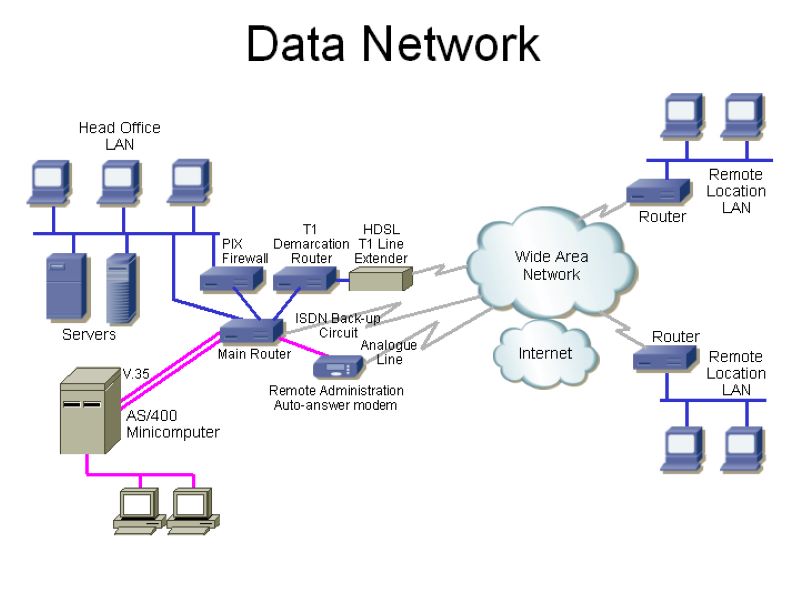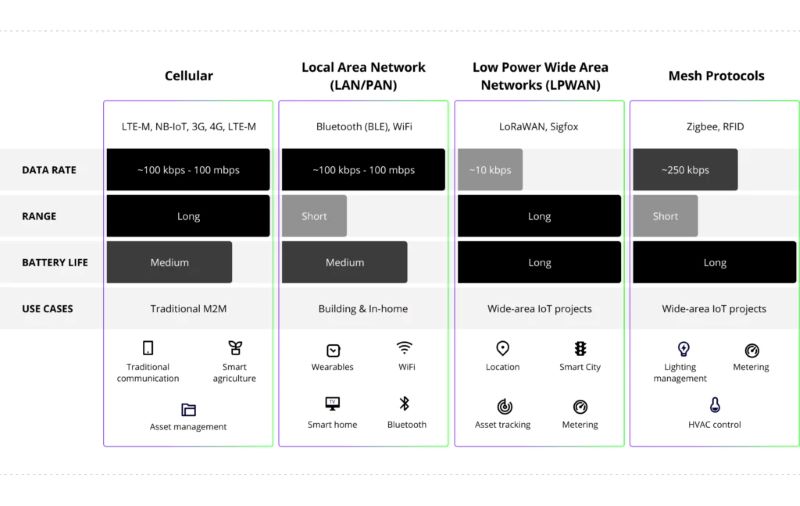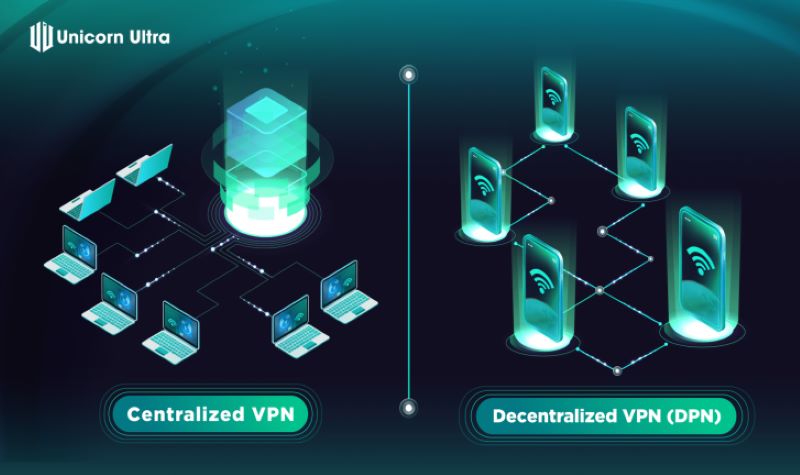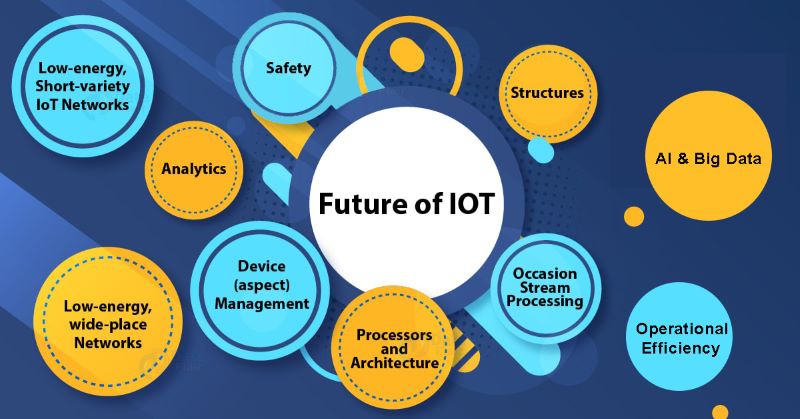Categories: Blockchain
The Importance of Data Networks in the Internet of Things (IoT)
"Data Networks" are crucial in connecting and transmitting information across various platforms. They enable efficient communication, data sharing, and processing, driving innovation and supporting the digital infrastructure in industries such as telecommunications, finance, and healthcare.
In the rapidly evolving landscape of the Internet of Things (IoT), the role of data networks is pivotal. As the backbone of IoT, data networks facilitate the seamless communication and data exchange among interconnected devices, driving innovation and efficiency across various industries. Without robust data networks, the transformative potential of IoT would remain largely untapped, leaving countless opportunities for enhanced connectivity and automation unrealized. This article explores the critical importance of data networks in IoT, highlighting how they enable real-time data transmission, ensure scalability, and enhance security, thereby laying the foundation for a smarter, more connected world.
Table of Contents
Data Networks: The Unsung Heroes of IoT
In the complex landscape of the Internet of Things (IoT), data networks stand as the unsung heroes, enabling seamless communication and data exchange among a myriad of interconnected devices. Serving as the digital nervous system of IoT, these networks facilitate the transmission of crucial information collected by sensors and IoT devices. Without robust and efficient data networks, the vast potential of IoT would remain untapped.
The significance of data networks in IoT cannot be overstated. They are responsible for the collection, processing, and analysis of the massive amounts of data generated by IoT devices. This data is then leveraged to gain insights, make informed decisions, and drive innovation across various industries. From smart homes optimizing energy consumption based on occupancy patterns to industrial sensors predicting equipment failures, data networks are the backbone of these transformative applications.

However, current data networks face several challenges that must be addressed to fully realize the promise of IoT. These challenges include:
- Speed: The sheer volume of data generated by IoT devices demands high-speed data networks capable of real-time information transmission.
- Bandwidth: As the number of connected devices continues to grow exponentially, data networks must have sufficient bandwidth to accommodate the increasing data traffic.
- Security: The sensitive nature of much of the data transmitted over IoT networks necessitates robust security measures to protect against unauthorized access and cyberattacks.
- Scalability: Data networks must be designed with scalability in mind to ensure they can adapt to the ever-expanding IoT landscape.
Innovative solutions are emerging to address these challenges. Projects like U2U Network, a blockchain-based platform, are exploring decentralized approaches to data transmission that could offer enhanced speed, security, and scalability for IoT networks. By leveraging the power of blockchain technology and incentivizing users to share their bandwidth, U2U Network aims to create a more efficient and reliable data network infrastructure for IoT.
Types of Data Networks in IoT
The Internet of Things (IoT) ecosystem relies on three main types of data networks, each offering unique strengths and facing distinct challenges: Wireless Networks (WLAN), Cellular Networks, and Low-Power Wide-Area Networks (LPWAN).
Wireless Networks (WLAN) use radio waves to transmit data between devices. Common examples include Wi-Fi, which is known for its high speed and extensive coverage but can be power-intensive, and Bluetooth, which excels in short-range communication with low power consumption. Zigbee is another example, tailored for low-power, low-data-rate applications, making it ideal for mesh networks and home automation.
Cellular Networks leverage existing cellular infrastructure to provide wide-area coverage and high bandwidth. Currently, 4G networks are widely deployed, ensuring reliable connectivity for numerous IoT applications. The emerging 5G technology promises even faster speeds, lower latency, and the capacity to connect a vast number of devices, significantly enhancing the IoT landscape.
Low-Power Wide-Area Networks (LPWAN) are specifically designed for IoT applications, offering long-range communication with minimal power consumption. LoRaWAN is known for its long range and low power usage, making it particularly suited for battery-powered sensors. NB-IoT, a cellular-based LPWAN technology standardized by 3GPP, provides wide coverage and deep indoor penetration, making it ideal for various IoT scenarios.

Each of these data networks plays a critical role in the IoT ecosystem, enabling seamless communication and data exchange among interconnected devices. As IoT continues to evolve, the development and optimization of these networks will be crucial in unlocking the full potential of this transformative technology.
U2U Network: A Decentralized Data Network Solution
U2U Network is a pioneering blockchain project transforming the way data is transmitted within the Internet of Things (IoT). By leveraging Directed Acyclic Graph (DAG) technology instead of traditional blockchain architecture, U2U Network has built a decentralized data network specifically designed for the unique demands of IoT.
This innovative approach offers several key advantages that address the challenges faced by conventional data networks:
High Speed: U2U Network's DAG architecture enables significantly faster transaction speeds than traditional blockchains, making it ideal for the real-time data transmission required by many IoT applications.
Scalability: U2U Network is designed to scale seamlessly as the number of connected devices grows, ensuring that the network can handle the ever-increasing demands of IoT.
Security: By decentralizing data storage and transmission, U2U Network eliminates single points of failure and reduces the risk of data breaches, enhancing the overall security of IoT data.
Transparency: The blockchain-based nature of U2U Network ensures transparency and immutability of data, fostering trust and accountability among users.
Incentivized Bandwidth Sharing: U2U Network incentivizes users to share their unused bandwidth, creating a more robust and resilient network while also rewarding participants for their contributions.

These advantages make U2U Network a powerful enabler of IoT dApps (decentralized applications) across a wide range of sectors. In smart cities, U2U Network can support real-time traffic management, environmental monitoring, and energy optimization. In smart agriculture, it can facilitate precision farming, livestock tracking, and supply chain management. In the supply chain industry, U2U Network can enhance transparency, traceability, and efficiency by securely transmitting data across the entire value chain.
The Future of Data Networks in IoT
The Internet of Things (IoT) is poised for a technological renaissance, deeply intertwined with the evolution of data networks. Emerging technologies are set to reshape this landscape, driving unprecedented levels of connectivity, intelligence, and security.
5G: The Catalyst for Real-Time IoT
The advent of 5G networks, promising lightning-fast speeds and ultra-low latency, will revolutionize real-time data transmission in IoT. This advancement will unlock new applications requiring instantaneous communication and response times, such as autonomous vehicles, remote surgery, and augmented reality. 5G's capacity to manage vast numbers of connected devices will also fuel the growth of smart cities, optimizing urban living through synchronized sensors and actuators.
AI: The Brain Behind IoT Intelligence
Artificial intelligence (AI) will emerge as the cognitive force behind IoT intelligence. AI algorithms will sift through extensive IoT-generated data, extracting invaluable insights and patterns beyond human capability. This capability will lead to more precise predictions, streamlined operations, and personalized experiences across industries. From predictive maintenance in factories to tailored healthcare recommendations, AI will empower IoT to make informed decisions and deliver enhanced value.

Edge Computing: Processing Power at the Edge
Edge computing, a transformative paradigm in data processing, will localize computation near data sources, minimizing latency and boosting IoT system responsiveness. By enabling real-time data processing at the network's edge rather than routing it to centralized cloud servers, IoT devices can make swift decisions and execute actions instantaneously. This capability is crucial for applications necessitating immediate responses, such as autonomous vehicles and industrial automation.
Blockchain and U2U Network: The Foundation of Decentralized Trust
The integration of blockchain technology into IoT data networks will usher in a new era of decentralization, security, and trust. Blockchain's inherent transparency and immutability provide a tamper-proof ledger for recording and verifying data, ensuring integrity and authenticity. U2U Network, a pioneering blockchain initiative, stands at the forefront of this movement, developing a decentralized data network tailored for IoT's distinctive requirements. By incentivizing bandwidth sharing among users and leveraging Directed Acyclic Graph (DAG) technology, U2U Network is forging a more resilient, efficient, and secure infrastructure for the future of IoT.
In conclusion, data networks serve as the lifeblood of the Internet of Things, enabling the seamless flow of vast amounts of data that allow devices to communicate, collaborate, and enhance our world. As the IoT evolves rapidly, the need for robust, scalable, and secure data networks becomes increasingly clear.
The future of IoT is intricately tied to the advancement of these data networks. With innovations such as 5G, AI, edge computing, and blockchain technology, we are witnessing a paradigm shift in how data is transmitted, processed, and secured. U2U Network, leveraging its decentralized approach and cutting-edge technology, stands at the forefront of this revolution. It empowers individuals and organizations to participate in and benefit from the expanding data economy.
The journey toward a fully realized IoT ecosystem continues, with data networks playing a pivotal role in shaping its trajectory. By embracing decentralized solutions like U2U Network, we can unlock the true potential of the IoT, fostering innovation, efficiency, and trust in a connected world.
.png)